Pudacuo ( or Potatso 普达措 ), officially known as Pudacuo National Park, is a surreal unpolluted Tibetan tableland with beautiful woodlands and forests, limpid lakes, lush meadows, and grazing yaks, gnus and all its thriving plants and vegetation and living beings against the backdrop of majestic peaks. It is a soul-recharging place with the great enjoyment of its serenity.
Pudacuo National Park lies about 22 km in the east of the downtown Shangri-la City, Yunnan Province. Shangri-la City is formerly known as Zhongdian which was renamed in 2001 as “Shangri-la” aimed at attracting more tourists, grabbing the tourists visiting its neighbour – Lijiang.
Shangri-la is a mythical Himalayan utopia, a permanently happy land described by James Hilton in his novel Lost Horizon. He probably based his writing on the articles published by National Geographic’s first resident explorer Joseph Rock, who visited Yunnan in the late 1920s and early 1930s.
The Utopia Shangri-la is coherent with Tibetans’ concept of Shambhala that describes a realm of harmony between man and nature that is also linked to the Kalachakra (“wheel of time”时轮).
Pudacuo is an earthly paradise that has been preserved and protected by the local Tibetans generations by generations. It is a crystallization of the harmony between man and nature, a small piece of Shangri-la or Shambhala (香巴拉).
So, the temptation to see Pudacuo is great! Follow us to have a glimpse of the pure land.
Around 9:00 am, 13 October, we get to the tourist service center of Pudacuo National Park, about 22 km in the east of the downtown Shangri-la. Mrs. Chen Ya, in our 3-people team, is formally assigned the job that mainly includes entrance tickets purchasing as well as the searching of the local travel information online or offline.
Not a tourist high season, soon she comes back with three tickets by the side of our white horse in the parking lot. I take a picture of the ticket using my iPhone camera. Wow, it is not cheap: entrance fee 138 yuan + shuttle bus fee 120 yuan (Note: The half of the ticket can be used as a post card ).
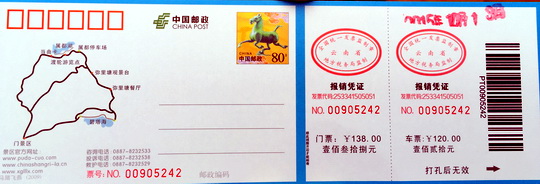
We enter the tourist service center and line up in front of the entry gate, waiting in turn for swiping the tickets and getting on a shuttle bus parking by the gate. There are still many tourists – some are individual tourists like us and there are more tourists traveling in groups with their tour guides holding guide flags, making the entrance area a bit crowded. The shuttle buses are operated based on free seating, filled up and go.
The Pudacuo National Park mainly comprises three parts – Shudu Lake (属都湖), Militang Alpine Pasture (弥里塘) and Bita Lake (碧塔海). The eco shuttle buses are scheduled to take us to these three places. At Militang Alpine Pasture, people are only given 10 minutes for picture taking and viewing the grandeur grassland while bused on route from Shudu Lake to Bita Lake.
So you will spend most of your half day trip to Pudacuo on the two scenic spots – Shudu Lake and Bita Lake. It is a 13 km shuttle bus drive from the tourist service center to Shudu Lake.
At Shudu Lake, you can either walk on board walks around the lake ( 3.3 km walk ) or you may take a boat cruising on the lake (50 yuan); same with Bita Lake, you can either stroll on well maintained timber walkway around Bita Lake ( 4.4 km ) or take a boat (50 yuan) if you don’t have strong legs or you just want to cruise on the lake. We choose to walk on the both occasions, a total 7.7 km walk.
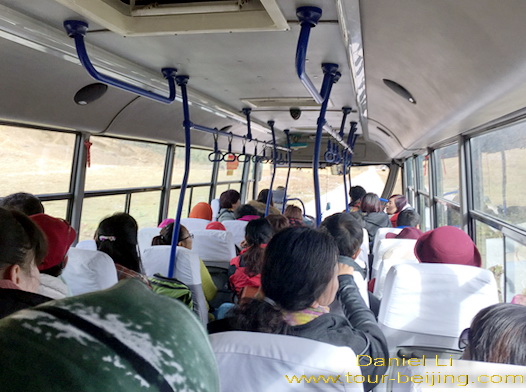
The 13 km bus ride is not dull at all. It is an exciting warm-up exercise before we are bused to Shudu Lake. Lush meadows, grazing yaks, clear streams and undulating hills flash past, unphotographable though I have taken out my camera for several times, trying to catch the roadside scenery.
Scenic Walk around Shudu Lake 属都湖
Soon a full busload of us arrives at the first stop known as Shudu Lake. “Shudu” literally means “cheese as sturdy as a stone” in Tibetan. It is a tectonic lake (构造湖) of geological fault (地质断层) with a high evelation of 3959 meters. Shudu Lake covers an area of 120 hectares with an average depth of 20 meters.
The overall ecological system of Shudu Lake comprises plateau lakes, swamped meadows, primitive dark coniferous forests with varied rare animals and plants resources. Autumn is the best time to view the lake scenery with inverted reflection in water and motley-colors. Walking a few steps and we see a well-maintained boardwalk winding above the swamped lake, easy for walk and good for the environmental protection of the lake.
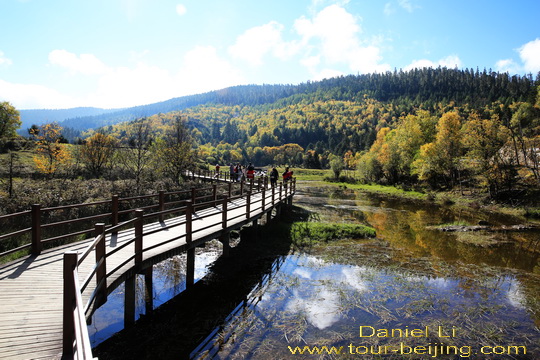
Late September and October, the whole lake is hemmed in by a palette of mixed colors like a fairyland on earth. It is the best time to view the multi-colored fall foliage on the surrounding forests with stunning inverted reflections in water.
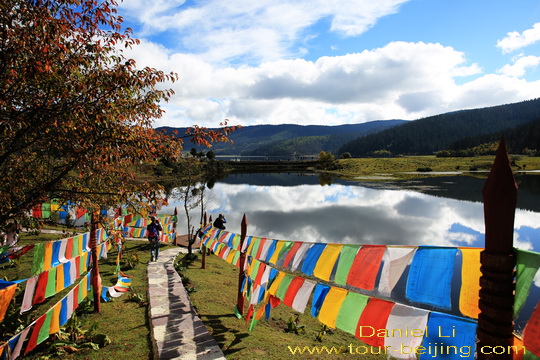
Shudu Lake has great inverted reflections in water, a scene for soul-recharging moments. Every step allows you to have a different angle of enjoying the stunning inverted reflections. Just watch your step while enjoying the views or taking photos.
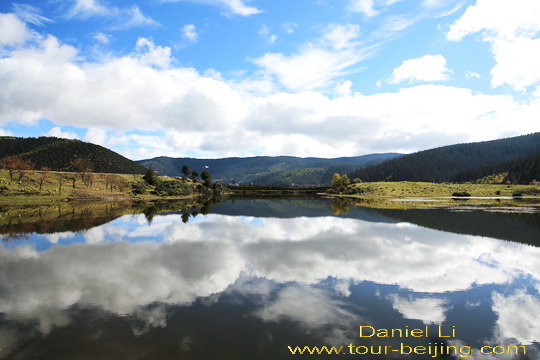
It is a mirage and very often it is difficult to tell the white clouds and the mountains upside down reflected in water. This is the primitive beauty of our nature, pure and unpolluted. Human beings should not be just content with a full stomach, we need clean and fresh air, and unpolluted environment.
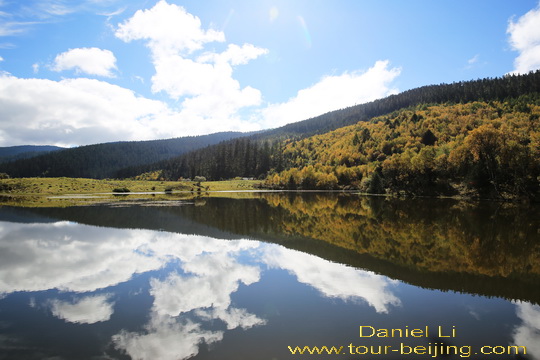
Soon we face two choices – walking further along the wooden walkway or taking a boat cruising on the lake. We definitely choose to stroll on the plank road around the lake, a scenic 3.3 km walk. The Shudu Lake boating costs you 50 yuan.
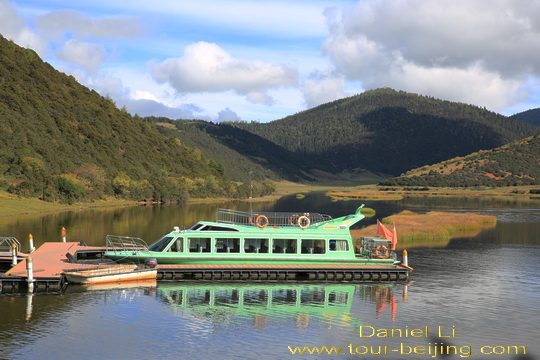
People are on the north edge of Shudu Lake standing on the suspended timber walk, turning left for the dock for lake cruising and right for the board walk along the lake. The high wooden walkway provides a good vantage of have a panoramic view of the lake and its surrounding meadows, trees and hills.
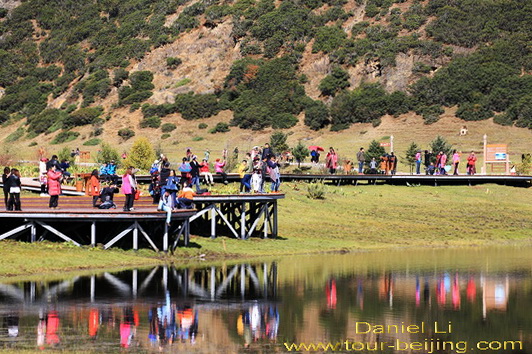
Shudu Lake is dotted with swamped yellow meadows given this time of the year. The golden-colored meadows look like large connected thick mattress and cushions, soft and warm.
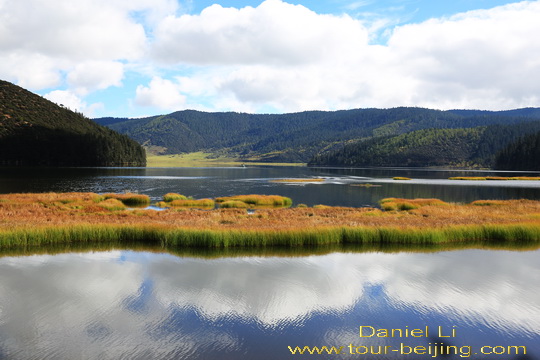
We are walking on the wooden walkway with our eyes busy in catching views and sights Shudu Lake has to offer. It is an amazing experience walking in the primitive forests by the lake.
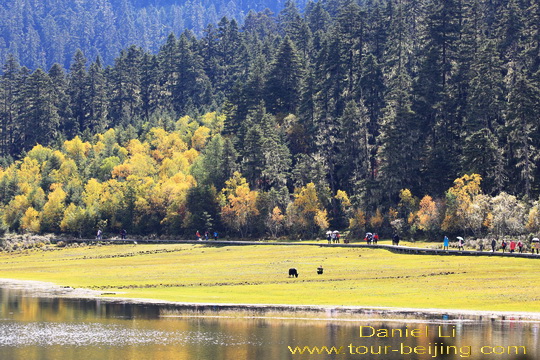
The water edge provides spectacular views – fall foliage and inverted reflections in water. My long-range camera does a very good job making copious pictures of these soul-refreshing moments.
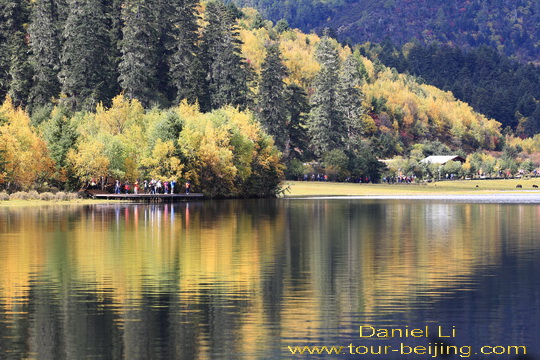
The water on the edge is dabbled with golden colors by the yellow coniferous forests in autumn. People enjoying the view also become part of it.
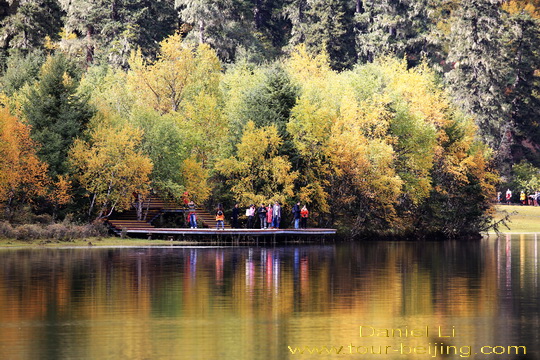
Fiery leaves with Spanish moss draped on the branches are a common sight here around the lake. It is said that only in unpolluted areas can such mosses like Spanish moss grow.
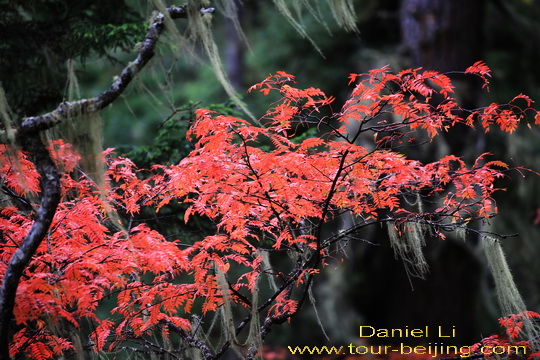
Motley-colored alpine trees, white Spanish moss, swamped meadows and the water edge dabbled with mixed colors like a palette, or an oil painting.
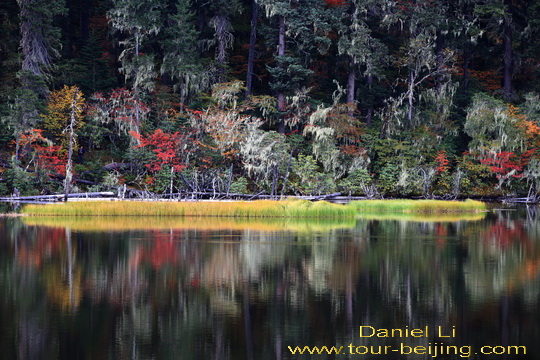
On the other side of the river bank is an expansive pasture dotted with Tibetan summer houses. The local Tibetans are grazing their yaks, sheep and horses, a bucolic and picturesque view!
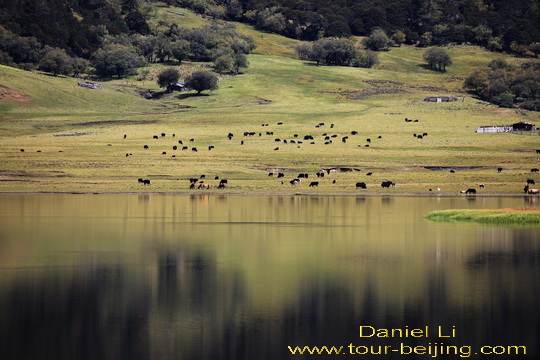
It is said that if you come here in May and June, you will be flooded with the sea of Rhododendrons blooming with bluish violet, yellow and pink colors. They grow around Shudu Lake and Bita Lake as well. Nothing is perfect and we have to enjoy the autumn hues while leaving the amazing Rhododendrons in our minds. Maybe we’ll return here someday in May or June.
The Shudu Lake scenic walk takes about 2 hours. We feel time is flying quickly especially if you are indulged in doing something. At the end of the 3.3 km Shudu Lake boardwalk is a simple service stop where we are supposed to wait for the eco shuttle bus going to the next sight – Militang Alpine Pasture.
Before going to the next stop, we sit down for lunch on the bench in a corridor of the service building. The service stop offers little choice of food. Fortunately, we have bought something to eat the night before, a good job done by Mrs. Chen Ya. Simply fed and then a short break, we go to the shuttle bus stop waiting in line for the next bus ride to Militang Alpine Pasture.
A Glimpse of Militang Alpine Pasture 弥里塘
Soon we are on a green shuttle bus bringing us to the next stop known as Militang Alpine Pasture. Militang literally means “a long and slim eye-like meadow” which resembles a narrow eye of Buddha. Militang is located midway between Shudu Lake and Bita Lake, 4500 meters long from north to south, and 500 meters wide from east to west with an evelation of 3700 meters.
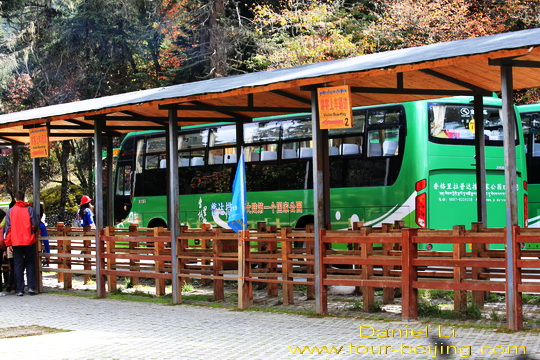
Miltang has varied landscapes – lush pasture, swamped meadows, meandering brooks. When spring and summer come ( May – September ), Militang looks like a huge green piece of smooth silk dotted with grazing yaks and sheep like pearls falling from the sky. The pasture is peppered with colourful wildflowers from May through September, an amazing spectacle in Pudacuo National Park.
In 15 minutes, we arrive at the viewing platform high above the pasture. Here we are only allowed to stay up to 10 minutes to take a few pictures and a glimpse of the expansive meadow below. We get off the bus, walk onto the viewing platform and quickly scan the legendary grassland below – Grazing yaks and horses, green and yellow mixed pasture surrounded by dark coniferous forests.
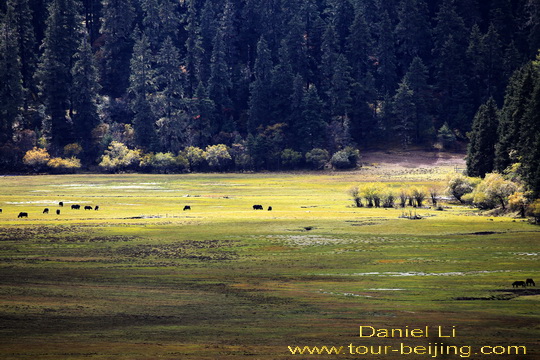
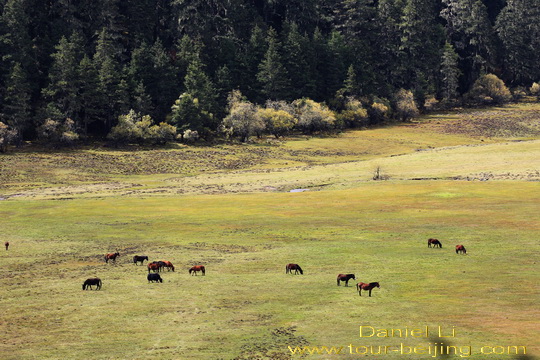
Walk around Bita Lake 碧塔海
We are bused to the last stop known as Bita Lake. “Bita” literally means “tufted oak tree leaves” (栎叶成毡). Bita Lake is well known for its ancient evergreen broad-leaves forests. Some of the oak trees (Quercus) along the plank road around Bita Lake boast over hundreds of years with average height over 20 meters. The Bita Lake timber walk is oft-lauded as “Corridor of Oak Trees”.
Again you have two choices 0f either walking around Bita Lake a (4.4km) or paying 50 yuan for a boat ride on the lake. We choose to walk on the plank road skirting the lake. The flora and fauna here are slightly different from those around Shudu Lake.
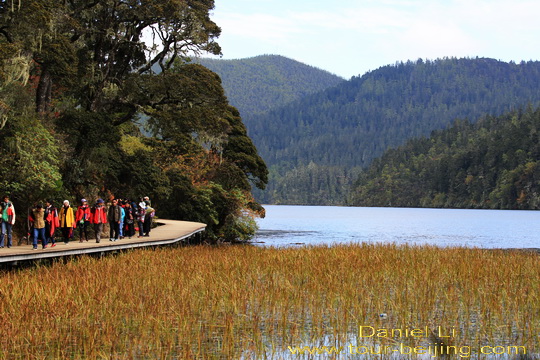
Some visitors choose to cruise across the lake over enjoying the surrounding views. Boat ride per person costs 50 yuan.
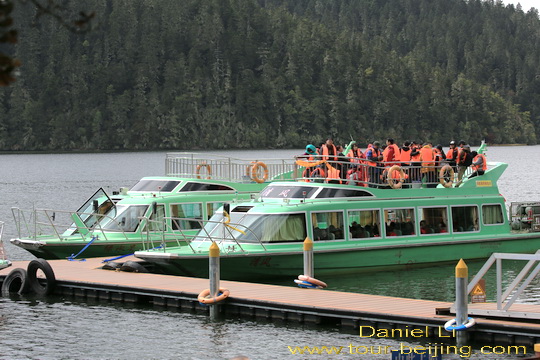
The Bita Lake wetland is listed as Ramsar Wetland (拉姆萨尔湿地) of international importance. There are three ecological systems on earth – wetlands, lands and seas. Wetlands are known as kidneys of the earth.
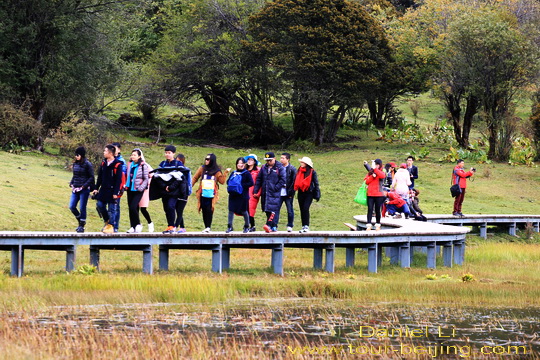
Walking on the plank road meandering the ancient forests by the lake, you are often welcomed by hospitable squirrels jumping in front of you requesting for food, spoiled? They are not afraid of visitors at all.
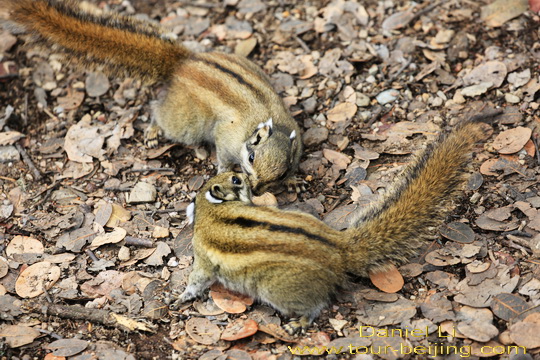
Even ultramarine flycatchers or the white-browed blue flycatchers (白眉蓝姬鹟) will fly to a trash bin looking for food showing little fear if someone is passing by.
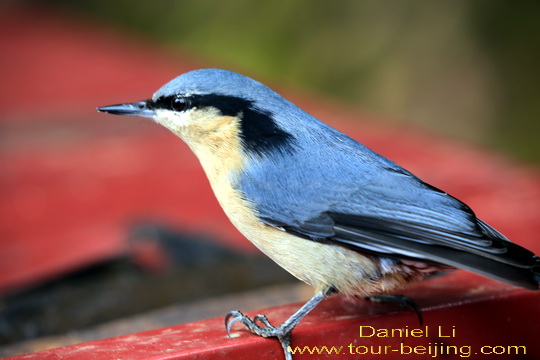
You will also see a kind of small and active bird known as northern Lapwing ( Vanellus vanellus 凤头麦鸡). Of course, Pudacuo is most famous for its black-necked cranes, but today we see none of them.
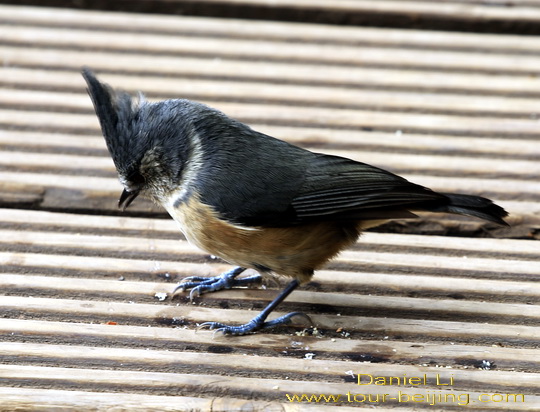
Ancient forests and golden meadows dotted with grazing horses, tranquil and serene, the harmony of nature.
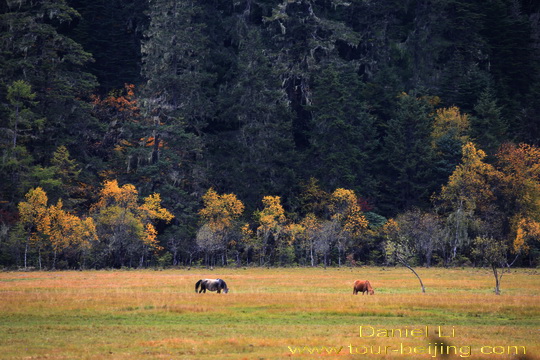
At 3:00 pm we find ourselves at the end of the Bita Lake plank road close to the north gate where our vehicle is parked. So the visit to Pudacuo National Park takes us 6 hours. Before we leave the park, we turn around and again have a look at the magical lake.
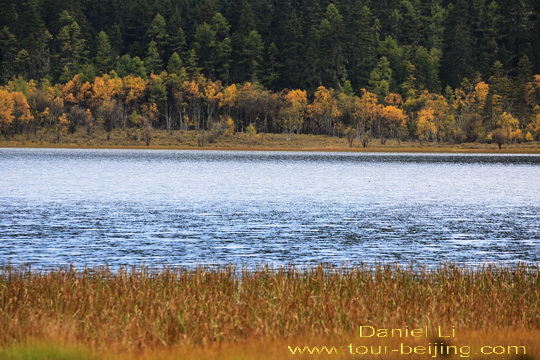
Any questions on Pudacuo National Park or how to get to Pudacuo Park by public bus, just drop a line.
Add-on
Drive from Hanzhong to Ya’an
Ya’an Night View
Most Beautiful Sky Road in China
Moxi Old Town ( Tips, Photos & Map)
Hailuogou Glacier Camp No.04 (Tips,Photos & Map)
Hailuogou Glacier Camp No.03 (Tips, Photos & Map)
Kangding (Tips, Photos & Map)
Drive from Kangding to Xinduqiao
Drive from Xinduqiao to Danba
Jiarong Tibetan Blockhouses
Jiarong Tibetan Ancient Watchtowers
Drive from Xinduqiao to Yajiang
Drive from Yajiang to Litang
Drive from Litang to Daocheng
Drive from Litang to Batang
Drive from Batang to Mangkang
Drive from Mangkang to Deqin
Kawagarbo Viewed from Feilaisi
Drive from Deqin to Shangri-la (Zhongdian)
Ganden Sumtseling Monastery Dwells Your Soul
Pudacuo is an earthly paradise
Drive from Shangri-la to Daocheng
Drive from Daocheng to Yading
Yading Brings You Inner Peace
Hassle-free Chengdu & Sichuan Guided Tours
If you don’t want to go the do-it-yourself route and prefer the hassle-free escorted tours, here are some options for Chengdu and Sichuan guided tours:
Chengdu tour
Chengdu Car Rental with Driver
Create My Chengdu Trip
Jiuzhaigou Tour
Sichuan Tour
Further Readings
Top 10 Attractions in Chengdu
Best Time to Visit Chengdu
Chengdu Airport
Railway stations in Chengdu
Chengdu Taxi
How to visit Wuhou Shrine
How to visit Du Fu Thatched Cottage
How to visit Jinsha Site Museum
How to Visit Tomb of Wangjian
How to Visit Wangjiang Tower Park
How to Visit Qingyang Taoist Temple
How to Visit Jinli Street
How to visit Kuan Alley and Zhai Alley
How to visit Qintai Road, Qintai Street Chengdu
How to visit Shaoling Road Bar Street
How to Visit Jiuyanqiao Bar Street
The Old Teahouse in Pengzhen Town, Chengdu
Bipenggou is a fairyland in Autumn
When is the best time to visit Jiuzhaigou?
Best Places to Visit Autumn Leaves in Sichuan
Top 10 Places to Visit in Sichuan
Ruoergai Grassland, my first trip to Ruoergai Grassland





